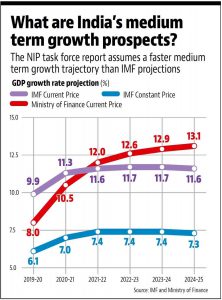JANUARY 1, 2020

On Tuesday, the Union finance ministry released the report of the task force on National Infrastructure Pipeline (NIP), which is aimed at making an investment of Rs 100 lakh crore in infrastructure projects over the next five years. Along with the details of proposed investment projects, the report also gives estimates of India’s nominal GDP from 2019-20 to 2024-25. These estimates can give us an insight into the government’s expectations about economic growth in the medium term and the revenue situation for the current fiscal year. The summary findings: lower revenue (and tax revenue) in 2019-2020 but better-than-expected medium-term growth.
Shortfall in nominal GDP growth in 2019-20
The report puts nominal GDP in 2019-20 at Rs 205.37 lakh crore with an annual growth of 8% over the Rs 190.1. lakh crore in 2018-19. The 2019-20 Budget had assumed the nominal GDP in the current fiscal year to be Rs 211 lakh crore assuming a growth rate of 12% over Rs 188 lakh crore as per revised estimates (RE) in 2018-19. Nominal GDP growth in the June and September quarter for the current fiscal year has been 8% and 6.5%.

Revenue shortfall
Even though the nominal GDP in 2018-19 was more than what was assumed in the Budget, revenue collections did not meet their budgeted targets. According to information given by the Controller General of Accounts (CGA) at the finance ministry, provisional net revenue (to Centre) collection in 2018-19 was Rs 13.61 lakh crore against RE figures of Rs 14.84 lakh crores given in the 2019-20 Budget. This gives a tax buoyancy figure – change in tax revenue per unit change in nominal GDP – of 0.53 in 2018-19. If a similar level of tax buoyancy is assumed for 2019-20, then the centre’s net tax revenue is expected to be Rs 13.72 lakh crore, only 83% of the Rs 16.49 lakh crore figure given in the Budget Estimates of 2019-20. Given the fact that the Centre has slashed corporate tax rates this year, it is likely that the tax buoyancy will be lower than what it was last year.
That could mean a shortfall in tax revenue. Corporate Tax collections up to November 2019 were Rs 2.88 lakh crore against Rs 2.91 lakh crore collected up to November 2018.
Medium-term growth
A comparison of the nominal GDP forecasts given in the report with International Monetary Fund’s (IMF) latest World Economic Outlook (WEO) projections, which were released in October last year, raises an interesting question. The IMF gives projections for India’s nominal and real GDP until 2024-25, the same period for which the report has given its estimates.
A comparison of the two shows an interesting pattern. While the government’s nominal GDP projections are lower than the IMF’s for the current and next financial year, they paint a better picture going ahead. To be sure, there is not much difference in the nominal GDP figures for 2024-25 in both the IMF (Rs 361 lakh crore) and government’s (Rs 365 lakh crore) estimates. (See Chart 1)
The bottom line
It will be interesting to see whether the IMF downgrades its projected GDP figures for India in its next WEO update which will be released in April. It should be kept in mind that the IMF’s October WEO forecasts came before the release of September quarter GDP numbers. If the IMF and government numbers show convergence, it would mean that both of them share the view that the current slowdown in the Indian economy is purely cyclical and will have no bearing on India’s medium-term growth potential.
However, if the IMF downgrades its projected GDP figures, it will imply that its assessment of the current economic slowdown is not the same as the government.
Courtesy/Source: Hindustan Times









































































































